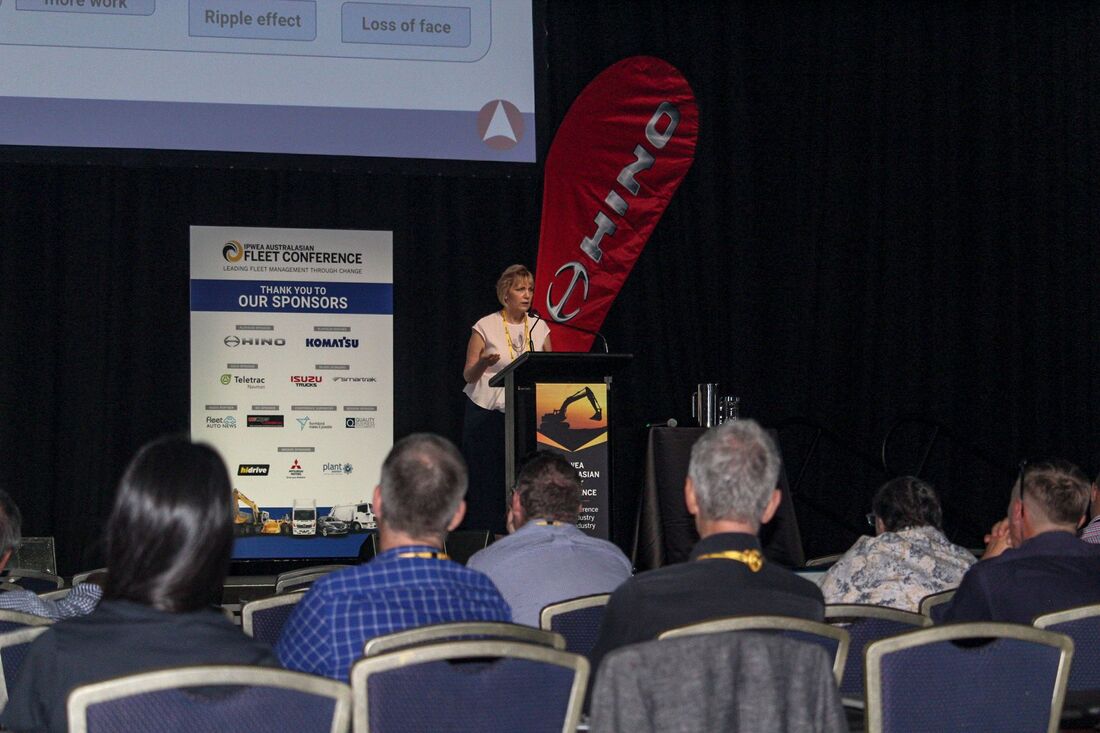|
Anne-Maree Coyne, Senior Consultant and co-owner of Modus Management, delivered a captivating presentation on change management to a large group of fleet practitioners at the IPWEA Fleet Management Conference on the 29th of March 2022. The conference was held at the Royal International Conference Centre in Brisbane.
Anne-Maree's presentation dealt with how change doesn’t just happen. She discussed how change needs to be planned and executed in a methodical way. Fleet practitioners had an opportunity to hear about the right way to manage change and achieve required outcomes as well as participate in an interactive session. The session covered change management principles, key leadership attributes and embedding change. In her address, Anne-Maree was able to draw on her extensive analytical skills as a lawyer and the expertise gained from running her own successful legal practice. She’s also worked as a senior change and project manager for top-tier international law firm, Allens Linklaters. There, she assisted lawyers and their client businesses in a diverse range of industries, to navigate pivotal change.
0 Comments
The Institute of Management Consultants, the professional body representing management consultants in Australia, has awarded CMC status to both Ken Goldberg, Managing Director, and Anne-Maree Coyne, Senior Consultant, with Modus Management.
CMC is a competency-based management consultant certification scheme open to full members of IMC. It is an internationally recognised certification recognised in 58 countries and is conferred by Management Consulting Institutes that are members of CMC-Global (ICMCI), the International Council of Management Consulting Institutes. IMC Australia is a founding member of CMC-Global and has sole responsibility of awarding CMC status in Australia. Ken Goldberg said "We're delighted to be part of a select number of consultants that decide to certify themselves with the CMC designation. We believe that CMC status sets us apart in the marketplace, with our clients, and as professional management consultant." Anne-Maree Coyne added that" CMC is a rigorous certification process that requires a consultant to have a record of successful assignments, the endorsement of recognised practitioners, the ability to demonstrate an ongoing commitment to management consulting, a record of continuing professional development, and a commitment to the IMC Code of Ethics." For further information about CMC status, please visit the Institute of Management Consultants website at https://www.imc.org.au/. by Ken Goldberg You’ve no doubt heard about keyless technology. Maybe you’ve even thought about it for your organisation or know an organisation which is implementing it. There is no doubt that a new reality exists where keyless technology has the potential to greatly facilitate vehicle sharing. So, what are some of the considerations for deciding if there’s a compelling case for adopting it? Keyless technology allows the operation of a vehicle’s locking and ignition without the use of a conventional, physical key. Many car owners in the general public seem swept away with the convenience of not being tied to conventional key. In the fleet context, it often but not exclusively, involves the use of a smart phone which, when in close proximity to an authorised vehicle, acts as a digital key. For example, a password code is sent to the driver’s phone using an app. The vehicle recognises the code and this enables the vehicle’s locking and ignition mechanisms to be activated. Staff access cards and the like can be used instead of smart phones. Ultimately, whether this type of technology presents a compelling case for adoption is going to vary from organisation to organisation. However, here are a few of the key considerations and questions that can inform and guide such a decision. Vehicle sharing? Some of the main benefits of keyless technology revolve around the existence and efficiency of vehicle sharing within an organisation. Therefore, it is relevant to any decision about the acquisition of keyless technology, whether an organisation has a pool of shared vehicles and, if so, to what extent and how efficiently the pool is managed. This is particularly so with respect to manual key administration for the vehicle pool. Costs of manual key administration? Has a costing been done of your organisation’s manual key administration? If not, this is a good place to start. Relevant considerations include the convenience which keyless technology can provide as well as answers to questions like:
Vehicle Security? Issues around vehicle security exist for both key operated and keyless fleets and each organisation will need to form its own view of the security risks posed by keyless technology based on its circumstances. There is no doubt that keyless technology has suffered from the stigma of hackers and a number of well publicised security risks. However, the National Motor Vehicle Theft Reduction Council concluded in their response to the ACCC’s 2016 market study of the new car retailing industry that the security concerns highlighted by the media often involved ‘complicated trial and error programming by computer experts with unrestricted access to their target vehicle’ and in their article entitled ‘Electronic Hacking: Hype or Reality’ they concluded that ‘while high tech theft methods steal the limelight, the reality is that more than 70 per cent of all theft is via the very low tech method of simply stealing the owner’s keys.’ Some of the vendors of the newer keyless technology certainly argue that the previous threats posed by hackers have been addressed. There are clearly some that argue that keyless technology provides a more secure system generally as it includes features like the ability for the digital key to be deactivated on-line and access to the vehicle blocked where a smartphone is lost or stolen. There are, of course, numerous other factors to contemplate as part of any rumination on the adoption of keyless technology for fleets. However, this represents a starting place and one thing is abundantly clear - keyless technology will continue to evolve and form part of the fleet landscape for the foreseeable future so it is a topic worthy of reflection. This article first appeared in IPWEA FLEET intouch e-news at https://www.ipwea.org/blogs/intouch/2019/06/16/keyless-technology-for-fleets-is-there-a-compellin by Ken Goldberg What if you had to wait at least 15 to 30 minutes every time you needed to fill up your car to get to your destination? You would probably get frustrated and look for alternatives. Right? This might be one of the key reasons why electric vehicles (EVs) struggle to be embraced by the wider community. Typically, consumers prefer to buy things that require minimal wait times, especially when it comes to fuel and energy needs. This is a key reason why product swapping came about as a concept. Exchanging products such as an empty bottle for one that has been pre-filled with something such as oil or gas is not new. Take for instance the SWAP’n’GO service offered by Elgas Ltd. Their gas refill exchange service enabled people to get instant gas bottle refills without waiting because it took too long for the average punter to refill a 4kg or 9kg gas bottle. Plus, the exchanged bottle has already been tested for leaks and checked for expiry dates to make the exchange fast, safe and easy. If we look at this same exchange concept for EVs, it may make sense to introduce a similar initiative. Why? Because charging EVs currently takes too long for lengthy trips. In fact, batteries can currently be charged by the fastest chargers (based on a capacity up to 450kW) for journeys at a rate of 3 minutes for every 100 km of available travel. This means that batteries can go from an approximately 10% to 80% charge in about 15 minutes. This is probably 10-12 minutes too long! Amazingly, the idea of battery swapping for EVs has been around for almost 20 years. The Israeli-founded company, Better Place, along with Renault promoted the battery-swap station idea from early 2000, especially in Australia. Senator Kristina Keneally had been State Premier when discussions took place between Better Place and the NSW government. However, nothing progressed and Better Place eventually filed bankruptcy in 2013. Senator Keneally recently indicated that people didn’t want swap stations, as was reported by The Australian in April of this year. But, maybe this observation is incorrect and the battery-swap idea was just ahead of its time. There are now a number of international companies gearing up in the EV battery-swap space. In China, Shanghai-headquartered NIO is a global start-up offering EVs and power services including a power swap station that can automatically exchange EV batteries in about 3 minutes. In India, joint venture SUN Mobility have developed e-vehicle vending machines that enable a 1-minute quick swap for 2- and 3-wheel vehicles. SUN Mobility have also partnered with Ashok Leyland who manufacture buses amongst other commercial vehicles. According to Mark Newton, a freelance writer for reset.org, the partnership has developed a robotic recharging unit that can swap 650kg bus batteries in around 3 minutes. In Taiwan, Gogoro now have an energy network of more than 1,226 battery swap stations that help power their Smartscooter™ supporting over 110,660 battery exchanges every day. As you can see, there are great examples where battery swapping and exchange stations are taking hold. This could be relevant for Australia. However, another significant issue in Australia is the amount of infrastructure required to support EV usage. With lack of charging infrastructure comes range anxiety, a term first coined in 1997 by Richard Acello, a San-Diego based journalist. Range anxiety develops from the worry that a vehicle might get stranded due to its inability to reach a destination greater than its capacity. Dr Darren Wishart, a senior lecturer at Griffith University, says that range anxiety and challenges associated with charging are factors contributing to widespread reluctance to embrace the use and uptake of EV’s. The key then is to guarantee that EVs can reach their destination. Based on the above, battery exchanges or faster charging stations are great ideas, as either temporary or permanent solutions. However, they aren’t the only answer. Government and corporate funding also need to be put in place for essential infrastructure to ensure large-scale adoption of EVs. Watch the video https://www.nio.com/nio-power This article first appeared in IPWEA FLEET intouch e-news at https://www.ipwea.org/blogs/intouch/2019/05/06/battery-swapping-for-evs by Ken Goldberg Working in the swiftly evolving management landscape nowadays means working in unfamiliar territory. Disruption is occurring at a fast pace from a colossal hunger for information causing many changes in traditional management practices and motivating the adoption of innovative methods and bourgeoning technologies. Decision-makers seek to turn information into insights to deal with a plethora of current and emerging issues. The hope is for new information systems to help achieve corporate aims and successful outcomes like guaranteeing the safest and most efficient, fit-for-purpose assets, optimising utilisation of resources, regulating behaviour of personnel to match corporate policies, establishing effective supply chains that provide value-for-money and mitigating business risk whilst maintaining a superior level of service and profit and/or cost control. However, there are existing software technologies that are providing sub-optimal results because they have been poorly architected, become outdated, been implemented inadequately or procured based on the wrong premise. So, how do you navigate the minefield of technology purchase? To achieve a successful acquisition and roll-out of software, businesses need to ask the right questions to determine what their primary objectives are before buying and locking into costly systems that profess to solve every conceivable management problem. However, it’s not always easy to ask the right questions to clearly define your objectives and, ultimately, it comes down to understanding the business’ needs. Theodore Levitt, the economist who popularised the term “globalisation” once said “people don’t buy a quarter-inch drill, they want a quarter-inch hole” meaning, it’s not about the function but rather the need. Needs can be about obtaining more controls and having less errors or doing things faster and cheaper. Maybe there is a need to gain insights for better decision making. Or, it could just be about simplifying work. As part of the process of asking the right questions and analysing the organisation’s needs, different agendas within the business may be uncovered which cloud the process. For example, a Manager may want to systemise the sales process, optimise the use of technical resources, and deliver competitive services. Whereas the Department Head may be looking to increase productivity, slash spending and improve reporting. At an even higher level, the CEO may be driven by the board to mitigate risk, tighten financial controls and maximise shareholder outcomes. In the end, this may add up to conflicting goals which create less clarity and poorly defined project initiatives. These can result in ill-conceived change management processes and lead to project failure. There has been much written about this phenomenon going back to the mid-1990’s when the highly regarded Harvard professor, Dr John Kotter, highlighted that about 70% of change initiatives fail. Sometimes failure can also be the result of other key contributors including incomplete specifications, lack of user input, changing requirements, lack of resources and lack of executive support. So, how do businesses establish clear goals and recognise needs to enable successful change to the right, new system? Organisations need to take a number of practical and analytical steps before they decide to buy a software technology and, sometimes they need to recognise that this may involve external assistance. These steps include doing the analysis to result in an accurate understanding of their strategic direction. This in turn allows them to focus on the ‘jobs to be done’. If they are heading in the direction of purchasing technology, they should give prior consideration to the change process and user experience. They should also pay attention to what will be required to streamline and automate current practices to meet objectives. Only then should software technology be applied. Yet businesses tend to get this back to front and acquire software first to solve their problems. Here’s what’s wrong with that. The typical evolution of a software provider is developing someone else’s streamlined methods. Not yours. Growing tech companies typically leverage a subject matter expert such as a smaller client that will help to validate their concept. R&D efforts take the form of customisations paid for by clients which become incorporated into market offerings. A minimum viable product is commercialised and becomes bloated with functionality as the client base increases. Eventually, a marketing representative promotes it as best practice. In addition, assessing software technology available on the market can be problematic because a large portion of functions seen during sales demonstrations may never be rolled out or used. A 2010 study by the Standish Group has shown that 95% of features and functions in packaged software are infrequently or hardly-ever used. In the same study, custom applications did better but a staggering 50% of features and functions were hardly-ever or never used. Therefore, it is important to determine smart practices first and identify modern technologies that can act as a platform for future growth rather than getting bogged down in the latest feature sets developed for other organisations. For businesses needing to replace existing traditional information system installations, the challenge will be identifying the gaps in current practices and potential drivers/resistance to change. Many of these legacy systems have evolved over time from areas such as finance, operations or asset management tools with kludged functionality. These incongruous systems have focused primarily on managing portions of a business lifecycle, offerings which have become industry-standard “table stakes”. So, it’s useful to recognise how much has changed in both the business and new software offerings since the purchase of the existing system. Compare the full set of needs and assess whether any offering being considered will, at the very least, provide the “must haves”. Also, beware of vendors and systems that have outdated system design, manual testing, crude project management methods and personnel, poor customer service, data integrity/privacy issues, and mediocre training, which should be front of mind when looking to modernise. In addition, as foreshadowed in the introductory comments, management teams are under new pressures and seeking fresh approaches due to changes in the economy, legislative matters and environmental concerns now and into the future. A range of really innovative technologies are upon us or on the horizon to deal with these types of issues including Internet of Things, Big Data, Blockchain, Machine Learning and Artificial Intelligence to name a few. These technologies have an ability to generate actionable data. This in turn provides solutions for business optimisation, predictive analytics, personalised services, deeper customer relationships and other critical areas. The key then is to identify systems with the greatest capacity and future capability to satisfy corporate objectives whilst incorporating newer methods and ease of use to manage beyond the asset. So, clearly businesses should analyse and diagnose before investing in software, establish a clear vision, involve people early in the project, select a solution that matches objectives, and continue to learn and adapt as the environment changes. Marvellous new technology is right here and there’s more on the horizon. Make sure your organisation is well placed to take full advantage of it and leave purchasing and implementation debacles behind. by Ken Goldberg Businesses have a continual challenge to stay relevant – no matter the size of the operation. We live in a fast-paced world where consumers seek better ways to fulfil their requirements and unmet needs. To that end, organisations must persistently re-examine their business models and existing structures to ensure a winning value proposition. This can be difficult for companies that need to balance ongoing operations with innovative practices. It can also be demanding for businesses dealing with compliance measures and an ever-changing environment while having growth aspirations. A typical strategy development process tends to deal with outcomes based on insights following a diagnostic process. Risk factors that can derail these outcomes should be part of the discourse. When organisational changes are necessary, it is worth considering the impact that risk factors have on strategic outcomes. This will help determine whether implementing the business leaders’ desired objectives to survive, adapt and flourish will succeed. Although not exhaustive, five distinct risk factors have been highlighted below and should be considered as part of the strategic process. These elements may seem obvious but are common risks that can hinder organisational initiatives: 1. Employee relations When considering strategic initiatives, evaluate whether employees are on board with the changes or will potentially cost the business in productivity - or worse.
2. Corporate knowledge Assess whether knowledge assets such as process, skills or other information which help to run operations more efficiently are applicable to any new strategic initiatives. Furthermore, an assessment of whether that corporate knowledge will be properly captured moving forward, should also be conducted as part of the strategic process. Otherwise, there could be adverse consequences related to security, productivity, market value and other areas of corporate knowledge.
3. Branding Understand the gap between the organisation’s market realities and desired image versus current branding. As part of the strategic process, make the appropriate changes so that targeted consumers can easily identify the offering and feel a connection to the business.
4. Internal systems and structure Recognise that existing internal systems have many dependencies across areas such as culture, structure, information systems, and other domains. These form a core part of prevailing operations and whilst they can be difficult to alter in times of change, they should be re-assessed and aligned with any new strategic direction.
5. Skillsets Evaluate the range of abilities within the organisation that will be required to holistically pursue and deliver the strategy. This may be based on functional areas such as sales, marketing, HR, finance to name a few. It is vital that the composition of skills reflects the overall approach and new skills may need to be acquired as part of the process.
Conclusion In order to successfully execute strategy, it is vital for organisations to ensure there are few to no impediments during the implementation phase. Common key risk factors such as the items described above, as well as some other critical factors, must be considered prior to the commencement of initiatives. Organisations and business leaders need to be proactive to deal with these factors so that strategic outcomes have the best chance to succeed. Additional Sources
by Ken Goldberg When it comes to managing a fleet of vehicles with some plant and equipment thrown in, large amounts of data are generated. With all the zeal around analytics and visualisation tools, you’d be right in thinking that a treasure-trove of information lies hidden within all this data. Uncover it and you’ll be able to gain insights into key business areas like asset utilisation, financial, behavioural and environmental concerns to name a few. However, attempting to analyse data and make key strategic decisions without having a core diagnostic process means fleet management strategy may largely be inadequate. Simply put, data does not equal strategy! Organisations should have fleet strategy processes in place or work towards improving these processes. Willie Pietersen, Professor of the Practice of Management at the Columbia University Graduate School of Business, says that strategy processes should be geared towards leveraging key insights to make critical choices about an organisation’s limited resources in order to outperform competitive alternatives. In relation to fleet, many organisations do a reasonable job using data to tactically manage their fleet. However, the reality is that stores of data can simply be overwhelming leading to minimal to no strategic insights and actions. So, what’s the answer? The key is to identify and understand the problem first and only then do you get to work on the data. This notion that data will uncover hidden gems is prevalent but as the world-renowned neuroscientist Beau Lotto states, data is meaningless without context because it doesn’t tell you what to do. Apparently, our brains are tuned for understanding relationships rather than processing absolutes. In fleet, this means that it is not about getting loads of data for example from your financial system, fuel provider or FMO. Rather, it’s more about considering relationships. Some examples that spring to mind include the relationship of refinancing and actual asset value used, fuel usage and driver behaviour, or servicing performance and technical skills training. Once the problems have been identified then it is time to find or collect the right data to help answer the question(s). This step can be tricky because data not only needs to be collected from the appropriate data source but then needs to be properly prepared so no values are omitted or are incorrect. Otherwise, results may not be accurately interpreted or trusted by decision-makers. So, the right data and data quality are of major importance to properly analyse data and harness insights. Once the data is prepared then it is time to do the analysis. Of course, most fleet-centric organisations already use tools like Excel or Google Sheets. Also, many use older more traditional or legacy “purpose-built” ERP-type fleet applications to help manage operations. But, how many fleet managers check the efficacy of data from these older applications? The NSW Government published an article on how systems can quickly become overloaded with vast volumes of problematic data leading to ineffectiveness. This is especially significant when data becomes orphaned or duplicated through data migrations, faulty code releases or a plethora of other database issues. These types of issues can severely affect analysis so data needs to be periodically and systematically cleansed or purged. Besides legacy systems, there are a range of modern-day tools that may be more suited for data analysis. A few examples include Tableau, Plotly, Highcharts, and NodeBox. These types of tools can be used with relational databases or for datasets that enter the realm of Big Data (more on that in a moment). That said, there are no faultless tools or applications - just solutions for people with certain goals and mindsets. It should also be considered that every tool and application will compel an organisation and/or a fleet manager down a pathway due to underlying design, functional and servicing limitations. A quick word on Big Data. The term Big Data has become ubiquitous in our daily lives and is now overused as a catch-all phrase for data management. So much so, that it seems to have lost the original meaning that was first coined by numerous individuals in Computer/Data Science and Econometrics back in the late 1990’s and early 2000’s. Big Data is a description of the quantity and even quality of a dataset that goes beyond the capacity of traditional relational databases and associated computer server infrastructure. Francis Diebold from University of Pennsylvania suggested that Big Data solutions tend to exceed file sizes of 200 GB. Of course, this may vary by organisation depending upon its resources and capabilities. However, typical near-real-time fleet-based data (excluding live GPS data) from sources such as finance systems, fuel, servicing etc. are typically still measured in tens to hundreds of megabytes rather than gigabytes. The good news is that relational databases are perfectly adequate to manage these dataset sizes. The real challenge is when datasets become much larger. An IBM whitepaper shows that vehicles can generate up to 1.3 gigabytes of data per hour from sensors such as GPS devices. This means an organisation with 500 vehicles will generate about 5.2 terabytes of data per day and approximately 1.9 petabytes per year. That’s a lot of vehicle and behavioural data. The bottom-line is that organisations and fleet managers should have diagnostic processes put in place to align with fleet strategy. These processes should help define questions about business problems that can be answered with data. Once problems are identified then the right data needs to be acquired, understood and prepared for analysis. Only then will trusted analysis provide the greatest chance of forming key actions based on trends and strategic insights. This article first appeared in IPWEA e-news at https://www.ipwea.org/blogs/intouch/2017/11/05/data-does-not-equal-strategy. |
|
© 2024 Modus Management Pty Ltd. All rights reserved.
|



 RSS Feed
RSS Feed